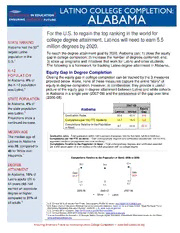
ERIC ED532094: Latino College Completion: Alabama PDF
Preview ERIC ED532094: Latino College Completion: Alabama
LATINO COLLEGE COMPLETION: ALABAMA For the U.S. to regain the top ranking in the world for college degree attainment, Latinos will need to earn 5.5 STATE RANKING million degrees by 2020. Alabama had the 33rd largest Latino To reach the degree attainment goal by 2020, Alabama can: 1) close the equity population in the gap in college completion; 2) increase the number of degrees conferred; and, U.S.1 3) scale up programs and initiatives that work for Latino and other students. The following is a framework for tracking Latino degree attainment in Alabama. K-12 Equity Gap in Degree Completion POPULATION C losing the equity gap in college completion can be tracked by the 3 measures In Alabama, 4% of provided below. Alone, none of these measures capture the entire “story” of the K-12 population e quity in degree completion. However, in combination, they provide a useful was Latino.2 picture of the equity gap in degree attainment between Latino and white cohorts in Alabama in a single year (2007-08) and the persistence of the gap over time (2006-08). STATE POPULATION In Alabama, 4% of 2007-08 the state population Alabama Equity was Latino.3 Latinos Whites Gap Graduation Rates 30.6 40.4 9.8 Projections show a Completions per 100 FTE Students 12.7 16.5 3.8 continued increase. Completions Relative to the Population 9.7 32.6 22.9 in Need MEDIAN AGE The median age of Graduation rates - Total graduation within 150% percent of program time for first-time, full-time freshman Completions per 100 FTE students – Total undergraduate degrees and certificates awarded per 100 full-time Latinos in Alabama equivalent students (incorporates part-time students) Completions Relative to the Population in Need – Total undergraduate degrees and certificates awarded was 25, compared to per 1,000 adults aged 18 to 44 relative to the adult population with no college degree 40 for White non- Hispanics.4 Completions Relative to the Population in Need: 2006 to 2008 DEGREE 31.3 30.6 32.6 ATTAINMENT Gap: Gap: In Alabama, 15% of 23.2 22.9 Latino adults (25 to 64 years old) had 9.7 8.1 8.6 earned an associate 2005-06 2006-07 2007-08 degree or higher, White Latino compared to 31% of all adults.5 1 U.S. Census 2010, American Fact Finder, Demographic Profile Summary. http://factfinder2.census.gov 2 U.S. Department of Education, National Center for Education Statistics, Common Core of Data (CCD), "State Nonfiscal Public Elementary/Secondary Education Survey", 2009-10, v.1b. www.nces.ed.gov/ccd 3 U.S. Census 2010: Alabama. http://2010.census.gov/2010census/data/ 4 U.S. Census Bureau, 2006-2010 American Community Survey. www.census.gov/acs 5 Lumina Foundation for Education. A Stronger Nation Through Higher Education. Educational Attainment Levels for the States. www.luminafoundation.org Ensuring America’s Future by Increasing Latino College Completion • www.EdExcelencia.org Degrees Conferred Another metric to benchmark college completion is to track the progress of total degrees awarded over time. This measure may be the result of an increase in overall enrollment numbers rather than an increase in rates of completion. From 2005-06 to 2007-08, • the number of Hispanics who earned an undergraduate degree in Alabama increased about 24% from 2006-08, while all other race/ethnic groups increased 6%. • among the 50 states, Alabama ranked 36th for the increase in degrees conferred to Latinos over 3 years. For more information on these metrics, download Benchmarking Latino College Completion to Meet National Goals: 2010 to 2020 and Degrees Conferred to Latinos: 2006-2008 at www.EdExcelencia.org/research/EAF/Benchmarking Examples of What Works for Latino Students There are institutions that are showing success in enrolling, retaining, and graduating Latino students. The following are examples of institutional programs across the country with evidence of effectiveness in serving Latino students nominated for Examples of Excelencia. Leadership and Involvement for Diversity, Engagement and Retention (LIDER) Program - Texas A&M International University The LIDER program is a leadership academy designed to engage Latino students in leadership activities throughout their college experience in order to promote academic success, retention, and graduation. The program’s mission is to increase retention rates, engagement, and leadership of first-year first-generation college-going Latino students. A total of 24 students participated in the freshman LIDER program, with 96% of those students successfully completing their freshman year and were retained at a 20% higher rate than students who did not participate. The LIDER program has also expanded to include a leadership program for upper level students. A total of 27 students participated in the upper classmen LIDER program, and these students averaged a 3.57 GPA. (http://www.tamiu.edu/studentaffairs/leadership.shtml) Seamless Transfer (SET @ UNT) Program – The University of North Texas SET @ UNT is a transfer program focusing on targeted online services to increase transfer rates and promote retention among transfer students. The program’s mission is to increase virtual and social engagement among Latino transfer cohorts, increase the use of academic and financial support services and programs among the target Latino transfer cohorts, and improve educational attainment of Latino transfer cohorts. The program provides tools to help Latino students’ transition and be academically successful at UNT, while also providing information to their parents/family. Through SET@UNT, students are able to connect with other transfer students and understand the importance of involvement on campus. Through the project 3,829 new transfer students were enrolled in the Blackboard SET@UNT site, with about 75 parents also participating in the program. (http://transfernow.unt.edu/) For more information on institutional programs improving Latino student success in higher education, access Excelencia in Education’s Growing What Works database at http://www.edexcelencia.org/examples Ensuring America’s Future partners in Alabama: Southern Regional Education Board: www.sreb.org Ensuring America’s Future by Increasing Latino College Completion • www.EdExcelencia.org
